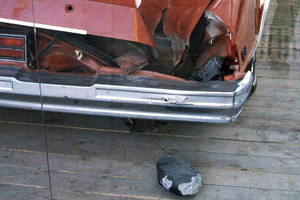 The 1992 'Peekskill' meteorite and its point of
The 1992 'Peekskill' meteorite and its point of
impact in Peekskill, New York. Credit: "Pierre ThomasWhy is it that meteorites are brought to me for identification in clusters? I don't mean that people bring clusters of meteorites-but it seems I get calls and visits from possessors of unknown rock samples, hopeful that they are of extraterrestrial origin, in bursts. This time I got two inquiries in two days!
The first thing I tell people is that I'm not a meteorite expert, but that I have a contact who is. This rarely discourages them from wanting to bring their rocks in for a look.
The first sample was brought in by a family who said they collected the chunk of iron from Lake Tahoe. This one actually looked promising to my mostly untrained eye: a fist-sized chuck of magnetic metal, with pits and holes and an overall melted look. I took some pictures to send off to our regional expert and told the family I'd call them to let them know what he said. The response to the pictures was pretty certain: it wasn't a meteorite, but a chunk of metallic slag. I was told that this is a common mistake; that often bits of slag from old foundries or other sources are taken for meteorites.
The second sample brought to me didn't really strike me as a meteorite, by appearance. It was metallic, but not magnetic; it was pretty heavy for its size; it didn't have any obvious signs of melting, and no real pits or holes-other than one, deep, tunnel-like hole the width of a finger. It didn't appear jagged or shrapnel-like, as fragments from an exploding metallic meteorite often do. Finally, it had wide, flat facets that looked much more like the result of natural rock cleaving as pieces of Earth's crust break apart.
I went ahead and performed a density measurement on the sample. It was pretty heavy, so our sensitive balance scales wouldn't handle the load. Instead, I resorted to our "learn your weight on other planets" scale-the one that tells you how much you would weigh on the Moon, Mars, and other planets, in addition to your Earth weight. (I found this scale useful when I had a package to mail and needed to know the weight; by selecting the Moon weight of the package, I would pay only one-sixth the normal Earth rate!)
